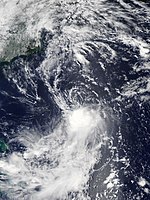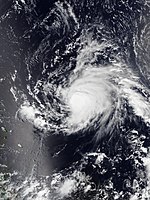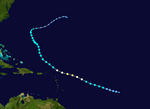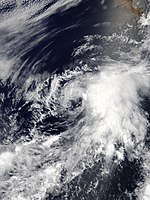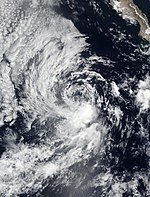User:CooperScience/TCR Rewrites
2019 Atlantic hurricane season[edit]
Subtropical Storm Andrea[edit]
| Subtropical storm (SSHWS) | |
| Duration | May 20 – May 21 |
|---|---|
| Peak intensity | 40 mph (65 km/h) (1-min); 1006 mbar (hPa) |
An upper-level trough originating in the mid-latitudes cut off into a broad upper-level low over Florida on May 17. The low moved eastward over the western Atlantic during the next day as a large area of cloudiness and showers developed to its east, and on May 19, it began to interact with low-level vorticity along the western edge of a dissipating cold front. The two systems had coalesced into a broad area of low pressure by 12:00 UTC on May 20., and convection associated with the low became better organized throughout that day as the system moved northward. By 22:00 UTC, an Air Force reconnaissance flight found that the system had acquired a well-defined center of circulation, and was producing gale-force winds well away from the center. Based on the aircraft data and the structure of the system, the National Hurricane Center (NHC) estimated that the system became Subtropical Storm Andrea at 18:00 UTC on May 20. However, the cyclone soon began to entrain dry air into its circulation while southwesterly wind shear increased, resulting in a rapid waning of the convection. By 12:00 UTC on May 21, Andrea's convection had dissipated, and the cyclone degenerated into a remnant low. The remnant low moved east-northeastward through the following day until at was absorbed by a cold front at 12:00 UTC on May 22.[1]
Tropical Storm Chantal[edit]
| Tropical storm (SSHWS) | |
| Duration | August 20 – August 23 |
|---|---|
| Peak intensity | 40 mph (65 km/h) (1-min); 1007 mbar (hPa) |
On August 14, a cold front moved across the Southeastern United States and became nearly stationary during the next few days. The pressure gradient between the frontal trough and an area of high pressure over the western Atlantic generated moderate southwesterly winds just off the coast. A small low-pressure system developed over southern South Carolina at 12:00 UTC on August 17 as a result of shear vorticity generated by the difference in winds between land and ocean. The small low moved northeastward across the coastal Carolinas, emerging over the Atlantic Ocean just south of Oregon Inlet at 18:00 UTC August 18. Although the low maintained a well-defined circulation through the following day, shower and thunderstorm activity remained poorly organized. On August 20, however, a more well-defined circulation had developed, and by 18:00 UTC, the system became a tropical depression. Later that evening, scatterometer data indicated the presence of tropical storm-force winds, and the depression strengthened into Tropical Storm Chantal at 00:00 UTC on August 21. However, marginal sea surface temperatures and moderate-to-strong southwesterly shear prevented Chantal from strengthening further, and it weakened to a tropical depression by 00:00 UTC on August 22. Chantal continued to gradually weaken, and by 18:00 UTC August 23, the depression degenerated into a remnant low as deep convection dissipated. The remnant low executed a slow clockwise loop over the next several days, gradually weakening until its dissipation soon after 18:00 UTC August 26.[2]
Tropical Depression Three[edit]
| Tropical depression (SSHWS) | |
| Duration | July 22 – July 23 |
|---|---|
| Peak intensity | 35 mph (55 km/h) (1-min); 1013 mbar (hPa) |
A tropical wave moved off the west coast of Africa on July 12, producing minimal convection as it moved westward across the tropical Atlantic for several days thereafter. The wave fractured as it approached the Lesser Antilles on July 18, with the northern portion turning northwestward and the southern portion continuing westward across the Caribbean Sea. The northern portion of the wave produced intermittent disorganized convection as it continued westward, reaching the southeastern Bahamas on July 21. Early the following day, a concentrated area of deep convection developed, resulting in the formation of a tropical depression at 12:00 UTC on July 22. However, environmental conditions proved unfavorable for the depression to strengthen, and deep convection decreased substantially shortly after formation. Although a small area of convection re-developed on July 23, it was insufficient to maintain the cyclone, and it degenerated into an open trough at 12:00 UTC on July 23.[3]
Tropical Storm Erin[edit]
| Tropical storm (SSHWS) | |
| Duration | August 26 – August 29 |
|---|---|
| Peak intensity | 40 mph (65 km/h) (1-min); 1002 mbar (hPa) |
On August 20, a large upper-level trough, accompanied by a large area of disorganized showers and thunderstorms, formed over the southwestern Atlantic. As the trough weakened, a shortwave moved into the western side of the trough over the Gulf of Mexico, resulting in the formation of a broad area of low pressure on August 22. The low drifted northwestward, moving over southeastern Florida on August 24 and degenerating into a trough of low pressure. However, deep convection increased along the trough early on August 26, and a new low developed. This marked the formation of a tropical depression at 12:00 UTC on August 26. The depression moved southwestward in response to a mid-level high near Florida, although it was poorly-organized due to northwesterly wind shear. Early on August 27, however, a large burst of convection developed, and the depression strengthened into Tropical Storm Erin at 18:00 UTC that day. Around that time, Erin turned sharply northwestward as the mid-level high over Florida weakened and a subtropical ridge strengthened to its northeast. Strong upper-level winds prevented Erin from strengthening further, and the cyclone weakened to a tropical depression at 18:00 UTC August 28. Accelerating northeastward, Erin transitioned into an extratropical cyclone at 12:00 UTC on August 29, and was absorbed by a larger extratropical low twelve hours later.[4]
Hurricane Jerry[edit]
| Category 2 hurricane (SSHWS) | |
| Duration | September 17 – September 24 |
|---|---|
| Peak intensity | 105 mph (165 km/h) (1-min); 976 mbar (hPa) |
A tropical wave moved off the west coast of Africa on September 11, accompanied by an area of disorganized showers and thunderstorms. The wave moved westward across the eastern tropical Atlantic during the next few days, spawning an elongated area of low pressure within the Intertropical Convergence Zone on September 15. As the wave continued westward, the area of low pressure moved slowly west-northwestward and gradually became better defined. By 06:00 UTC on September 17, the low had acquired a well-defined center and sufficient convective organization to be classified as a tropical depression. Initially slow to strengthen due to moderate northerly wind shear, the convection became better organized early on September 18, and the depression strengthened into Tropical Storm Jerry at 06:00 UTC that day. Afterward, Jerry steadily strengthened while over warm waters and a favorable atmospheric environment. On September 19, Jerry began a period of rapid intensification, reaching hurricane strength at 12:00 UTC that day and attaining its peak intensity with maximum sustained winds of 105 mph (165 km/h) twelve hours later. Shortly thereafter, strong upper-level winds and dry mid-level air caused Jerry to rapidly weaken while it moved quickly west-northwestward under a strong deep-layer ridge over the central Atlantic. Jerry weakened to a tropical storm at 00:00 UTC on September 21 as it turned northwestward around the western periphery of the ridge. The cyclone maintained an intensity of 65 mph (100 km/h) during the next couple of days as northwesterly shear persisted. A mid-level trough associated with Hurricane Humberto created a weakness in the ridge, causing Jerry to turn north-northeastward on September 22. By September 23, Jerry finally began to weaken as it resumed its north-northwestward to westward motion. By 18:00 UTC on September 24, deep convection had dissipated, and Jerry became a gale force post-tropical cyclone while it was located 280 mi (450 km) west-southwest of Bermuda. The post-tropical cyclone continued to gradually weaken, with winds decreasing below gale force on September 25 as it passed near Bermuda. The low then degenerated into a trough of low pressure about 415 mi (670 km) east-northeast of Bermuda on September 28.[5]
Tropical Depression Fifteen[edit]
| Tropical depression (SSHWS) | |
| Duration | October 14 – October 16 |
|---|---|
| Peak intensity | 35 mph (55 km/h) (1-min); 1006 mbar (hPa) |
A vigorous late-season tropical wave, accompanied by a broad area of low pressure and a large mass of deep convection, moved off the west coast of Africa on October 13. The broad low separated from the parent wave, moving slowly northwestward as the wave continued westward across the tropical Atlantic. Thunderstorm activity associated with the low became better organized early the following day, resulting in the formation of a tropical depression at 12:00 UTC October 14. As the depression moved northwestward toward the Cape Verde islands, it encountered a hostile environment of high wind shear and abundant dry air, which prevented further strengthening. The depression quickly became poorly organized, and it degenerated into a broad area of low pressure by 06:00 UTC October 16. The remnant low continued northwestward, producing intermittent convection until its dissipation at 18:00 UTC on October 17.[6]
2019 Pacific hurricane season[edit]
Tropical Storm Cosme[edit]
| Tropical storm (SSHWS) | |
| Duration | July 6 – July 7 |
|---|---|
| Peak intensity | 50 mph (85 km/h) (1-min); 1001 mbar (hPa) |
A tropical wave moved off the coast of Africa on June 23, producing limited convection as it moved quickly westward across the tropical Atlantic. The wave was poorly defined when it crossed South America on June 27, but became better defined as it emerged over the eastern North Pacific on July 2. A broad and elongated area of low pressure developed along the wave axis on July 4, and by July 5 the disturbance was producing tropical storm-force winds. Early on July 6, deep convection near and to the east of the broad low pressure system increased and became better defined, and a well-defined center developed at 12:00 UTC that day, marking the formation of Tropical Storm Cosme about 750 mi (1210 km) west-southwest of Manzanillo, Mexico. Due to an anomalous pressure gradient between Cosme and western Mexico, the tropical storm was already at its peak intensity of 50 mph (85 km/h) at the time of genesis. Unfavorable environmental conditions prevented Cosme from strengthening, and the cyclone weakened as it moved west-northwestward, and then northwestward as it moved around the southwestern periphery of a ridge centered over Mexico. By 00:00 UTC on July 8, central deep convection had dissipated, and Cosme degenerated into a remnant low about 660 mi (1060 km) west-southwest of the southern tip of the Baja California peninsula. The remnant low slowed and turned to the west on July 10 before opening up into a trough early on July 11.[7]
Tropical Depression Four-E[edit]
| Tropical depression (SSHWS) | |
| Duration | July 12 – July 13 |
|---|---|
| Peak intensity | 35 mph (55 km/h) (1-min); 1006 mbar (hPa) |
A tropical wave moved westward off the coast of Africa on June 30, reaching the Lesser Antilles on July 4 and then crossing Central America on July 7. Deep convection associated with the wave increased markedly when it reached the eastern Pacific Ocean on July 8, although it remained disorganized as the wave moved westward to the south of the Mexican coast over the next several days. A small area of low pressure developed from the disturbance at 06:00 UTC on July 12, and became sufficiently organized to be classified as a tropical depression six hours later. Although located over warm waters, moderate east-northeasterly wind shear prevented the depression from strengthening significantly, and the cyclone degenerated into a remnant low at 00:00 UTC on July 14. The remnant low produced intermittent bursts of convection as it moved west-northwestward before dissipating shortly after 06:00 UTC on July 15 about 610 mi (980 km) west-southwest of the southern tip of the Baja California peninsula.[8]
Tropical Storm Dalila[edit]
| Tropical storm (SSHWS) | |
| Duration | July 22 – July 25 |
|---|---|
| Peak intensity | 45 mph (75 km/h) (1-min); 1004 mbar (hPa) |
A tropical wave, accompanied by a distinct area of disturbed weather, moved off the west coast of Africa on July 8. The disturbance displayed some signs of organization as it moved westward across the deep tropical Atlantic and the Windward Islands. As it passed near the island of Curaçao on July 15, weather radar indicated cyclonic rotation at the mid-levels. However, the wave lost much of its convection during the next few days as it continued westward across the Caribbean Sea and Central America. Convection gradually increased as the system continued westward over the eastern North Pacific while a broad area of low pressure developed in association with the system. By 06:00 UTC on July 22, the disturbance had acquired a sufficiently defined center of circulation to be classified as a tropical depression while about 690 mi (1110 km) southwest of the southern tip of the Baja California peninsula. Due to the effects of northerly shear and marginal ocean waters, the cyclone's center remained devoid of deep convection. However, warmer waters to the south of the center allowed for a brief period of strengthening as the cyclone moved northwestward, and it became Tropical Storm Dalila at 06:00 UTC on July 23, reaching a peak intensity of 45 mph (75 km/h) six hours later. Weakening soon began as the cyclone moved over cooler waters, and Dalila weakened to a tropical depression at 06:00 UTC on July 24. At 12:00 UTC the following day, Dalila degenerated into a remnant low over the cold waters of the north Pacific. The remnant low meandered westward for another day before dissipating at 18:00 UTC on July 26.[9]
References[edit]
- ^ Andrew S. Latto (August 6, 2019). Tropical Cyclone Report: Subtropical Storm Andrea (PDF) (Report). Miami, Florida: National Hurricane Center. Retrieved August 9, 2019.
- ^ Robert J. Berg (October 25, 2019). Tropical Cyclone Report: Tropical Storm Chantal (PDF) (Report). Miami, Florida: National Hurricane Center. Retrieved November 4, 2019.
- ^ David A. Zelinsky (August 19, 2019). Tropical Cyclone Report: Tropical Depression Three (PDF) (Report). Miami, Florida: National Hurricane Center. Retrieved August 22, 2019.
- ^ Eric S. Blake (November 15, 2019). Tropical Cyclone Report: Tropical Storm Erin (PDF) (Report). Miami, Florida: National Hurricane Center. Retrieved November 24, 2019.
- ^ Daniel P. Brown (December 11, 2019). Tropical Cyclone Report: Hurricane Jerry (PDF) (Report). Miami, Florida: National Hurricane Center. Retrieved December 28, 2019.
- ^ Lixion A. Avila (November 1, 2019). Tropical Cyclone Report: Tropical Depression Fifteen (PDF) (Report). Miami, Florida: National Hurricane Center. Retrieved November 3, 2019.
- ^ David A. Zelinsky (August 19, 2019). Tropical Cyclone Report: Tropical Storm Cosme (PDF) (Report). Miami, Florida: National Hurricane Center. Retrieved August 25, 2019.
- ^ Robert J. Berg (August 6, 2019). Tropical Cyclone Report: Tropical Depression Four-E (PDF) (Report). Miami, Florida: National Hurricane Center. Retrieved August 9, 2019.
- ^ Lixion A. Avila (August 9, 2019). Tropical Cyclone Report: Tropical Storm Dalila (PDF) (Report). Miami, Florida: National Hurricane Center. Retrieved August 18, 2019.







